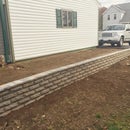Introduction: Vintage Style Garden Stake Tripod
I wanted an appropriate tripod to go with my Vintage Camera Lamp.
Sadly, I couldn't find anything locally that fit what I wanted. The only things I could find were antiques that were selling for hundreds of dollars. Since my purposes were purely decorative and I didn't need a fully functioning tripod I decided to make my own. The problem was that I don't have much in the way of power tools or a workshop that could hold them, so I decided to use garden stakes, a few tools, and some brass hardware to get the job done. With a general vision for what I wanted, and the help of my girlfriend, the project began.
Step 1: Materials
- Garden stakes or similar. Pallets would do if you have a table saw.
- 1/4 20 brass bolts. 3in. long (6)
- Matching brass butterfly nuts (6)
- Small piece of scrap wood approx. 5x5 in.
- Brass strips
- Small brass wood screws
- Stain
- Rag
-1/4 20 Bolt for attaching the camera
- 3 finishing nails
- 3 wood screws (These do not need to be brass as they will be hidden)
Step 2: Tools
- Sander or sandpaper
- Dremel
- Hammer
- Saw
- Drill
- Screwdriver
- Hot glue gun
Step 3: Measure and Cut
The first thing to do is to sort through the stakes to be sure you are picking the ones that aren't cracked, broken, or knotted. You also want to make sure they are similar thickness, it might not be obvious now but it matters later. Pick 9 of the best ones you can find and lay them out the way you want your legs to be. Depending on the finished height you want, measure and cut the stakes so that only 3 have a pointed tip and the rest are flat.
Step 4: Sand!
Since garden stakes are fairly rough, we sanded them down and rounded some of the corners so they'd be a little more uniform. The stakes come with 2 corners on each side already rounded. You could probably go rough and skip this step if you really wanted to, but some sides are much smoother than others to begin with, and we were going for a uniform look. This is also one of the longest steps.
Step 5: Drill
After some careful measuring and marking, line up where you want the bolts to go and drill. This step is very difficult without a drill press, since staying completely vertical through all 3 pieces takes some skill. You will need to drill twice in each leg. Once at the bottom connection and once where the top of the legs connect to the tripod base that will hold the camera. I recommend you drill through all 3 pieces at once, that way you can put the screw in right away and bolt it on. If you mix up the legs later on, it will be annoying to match them back up.
Step 6: Making the Base
This is where the piece of scrap wood comes in. I went with a triangular base for simplicity. It's fairly straightforward to attach 3 legs to a triangular shape. First I cut out the triangle and sanded it down and rounded the edges. Then I drilled out the middle to accept the 1/4 20 bolt for the camera mount. The 1/4 20 bolts I had were 2 short, so I had to carve some space with the dremel to let it sit deeper inside the wood.
After that was finished I needed a way to connect the legs to the base. I cut 3 small pieces and drilled holes in each of those. I ended up drilling them off center because I realized I made the base a little bit small and was worried about clearance for the legs. I decided to nail them to the base, so I drilled a hole to keep them from cracking. The nails ended up being a bad idea because they allowed the legs to spin freely. Avoid my mistake and go with wood screws from the beginning.
Step 7: Test Fit
At this point you're ready to put everything together and see how it fits, then its time to take it all apart again! Before you do, make sure you LABEL all your pieces.
Step 8: Stain
I wanted a contrast between the brass and the wood, so I chose a dark stain. Before I stained any of the pieces I'd worked so hard on, I did a test with one of the spare stakes to see how long I wanted to leave it on before wiping. I marked off 3 sections and did 5 minute increments. I ended up going with 5 minutes. After each piece was stained we laid them out to dry overnight.
Step 9: Reassemble
After the stain is dry, its time to put all the brass hardware in and bolt it tight. Since my tripod is not going to be adjustable I put a finishing nail in each joint to keep them from moving. You could make it adjustable if you wanted to simply by drilling more holes in each pointed leg section and sliding them up or down.
Step 10: Brass
To add the brass strips, I drilled a hole in one side of the brass and screwed it in with small brass wood screws. Then I bent the sheets all the way around the leg and drilled into the other side where it was held by another screw.
Step 11: Thats It!
There you have it! Let me know if you have any suggestions, feel free to ask questions and tell me if I've left anything out.
Thanks for reading!













